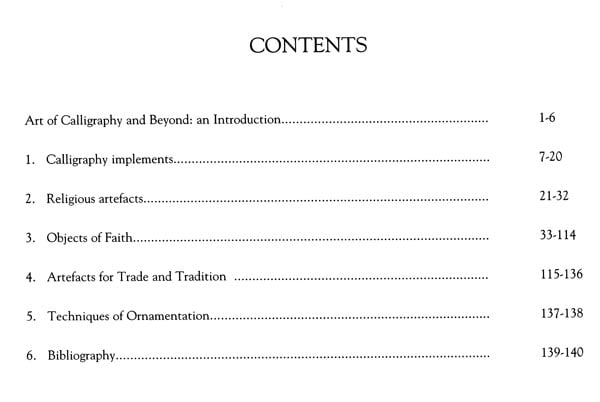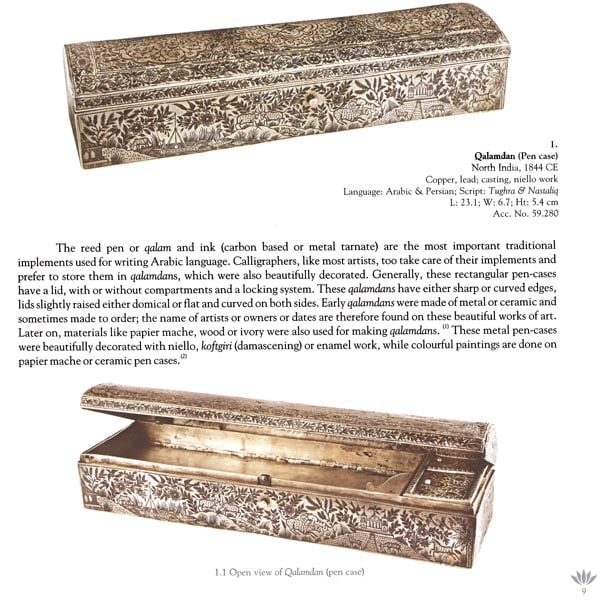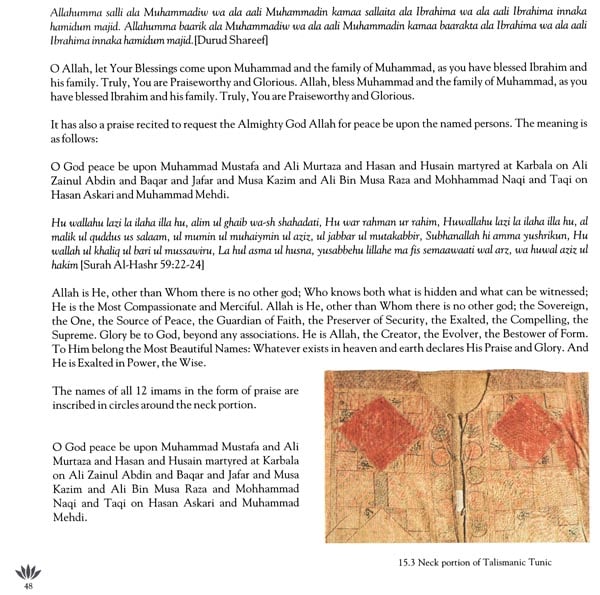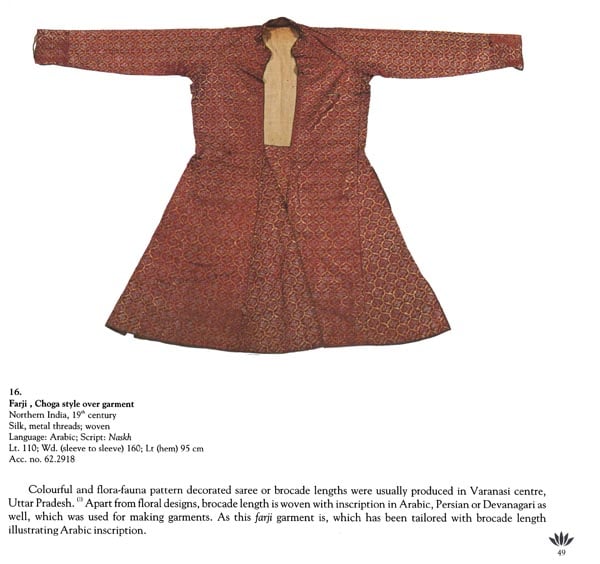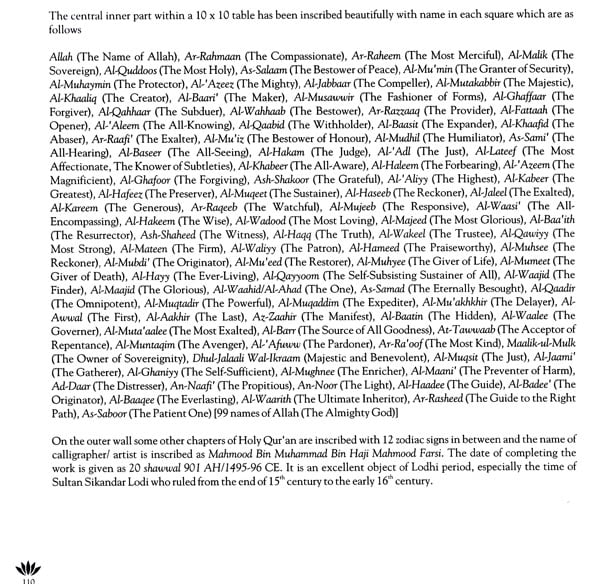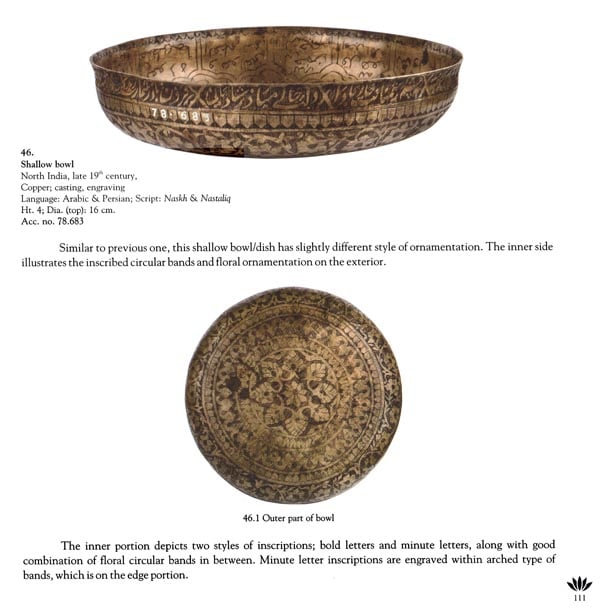
Art of Calligraphy and Beyond (Arabic and Persian Inscriptions on Objects of Decorative Art, National Museum)
Book Specification
| Item Code: | NAR823 |
| Author: | Dr. Anamika Pathak , Dr. Nasim Akhtar and Zahid Ali Ansari |
| Publisher: | National Museum, New Delhi |
| Language: | English |
| Edition: | 2015 |
| ISBN: | 8185832382 |
| Pages: | 150 (Throughout Color Illustrations) |
| Cover: | HARDCOVER |
| Other Details | 9.50 X 9.50 inch |
| Weight | 850 gm |
Book Description
The museum's main responsibility is to collect and preserve arte facts, carry out research and from time to time mount temporary and permanent exhibitions for public viewing. An exhibition of fifty-five arte facts titled, "Art of Calligraphy and Beyond: Arabic-Persian Inscriptions on Decorative arts object" was mounted at the National Museum, New Delhi in 2015.
Calligraphy, the art of fancy lettering of a script, is one of the most important aspects of different cultures. Various arte facts, in Islamic culture, portray the beautiful Arabic-Persian inscriptions, which were artistically blended with flora-fauna designs and add charm to objects. The exhibition mainly focused on the vast scope of a calligrapher's / craftsman's work, which is not confined to paper and architecture but also appeared on beautiful arte facts such as metal ware, pen-cases, bowls, plates, alams , wooden boxes, mendicant bowls, amulets, textiles and costumes.
The exhibition was curated by Dr. Anamika Pathak and Shri Zahid Ali Ansari and layout was designed by Shri Kuldeep Prasad and Ms. Priya, which was mounted under the guidance of Shri K.K.S. Deori. My appreciation and gratitude for Shri R.P. Savita and Anand Kumar who, along with their team had conserved and restored the arte facts and brought them to a presentable state for the exhibition. This researched catalogue is an important work which has been authored by Dr. Anamika Pathak, Dr. Naseem Akhtar, an authority on Arabic-Persian language and Shri Zahid Ali Ansari.
I do hope that this catalogue will enrich the readers' experience of the art of calligraphy and create an interest among students and researchers for a deeper understanding of history, art and calligraphy in Islamic culture.
Calligraphy is an artistic expression of written words in Islamic culture, although it is equally important in Chinese, Japanese and other cultures."' In its broadest sense, Islamic calligraphy is roughly equivalent to the Arabic noun khatt, defined in Arabic-English Lexicon as 'line, streak or stripe, track, path or road, and writing and the like'. ' The Arabic noun khatt also includes the idea of writing. It refers to the script that the writer intended to impact the viewer aesthetically with; writing, that not only conveys information by its semantic content but also speaks through its formal appearance.
The extensive use of calligraphy reached its hallmark in Islamic culture. It became the main and sometimes the only element of decoration. This was perhaps due to the central role of the 'word' in Islam. Its importance is clear from the five verses in the Qur'an, generally reckoned to be the first words revealed to the Prophet Muhammad (PBUH):
In the Name of God, the Merciful, the Compassionate, Recite: In the name of thy Lord who created, created Man of a blood-clot. Recite: And thy lord is the Most Generous, who taught by the Pen, Taught man that he knew not. Chapter 96 [Icira' or al 'Alaci] '
In other words, the knowledge of writing distinguishes man from God's other creatures. The importance of writing runs throughout the Qur'an. There are several such references; one such reference opens with the words,
'Nun. By the Pen, and what they inscribe'. Chapter 68 [Surat-al-Qalam]
Another factor of importance for writing is perhaps the discouragement of figurative work in Islamic art. So, the art of calligraphy was developed around natural surroundings-God's creation. Nature symbolizes purity and is considered closer to the Almighty. Although the early Qur'anic text was never illustrated, artists in later periods incorporated imagery. Initially, artists were restricted to use of many skilled variations of innocuously stylized plants or geometrical forms. The most common art form that appeared was continuous the star pattern, which usually appears in combination or conjunction with Arabic writing. Arabic language was used for writing the Holy Book, Qur'an in Kufic script.' Arabic calligraphy is attached to the importance of Arabic in Islam as the use of Arabic is compulsory in prayers and is the Language of the Qur’an and the language of Paradise.
